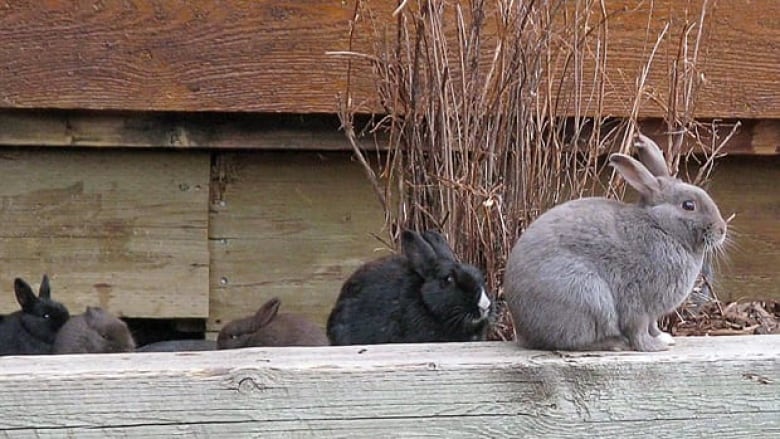Bunny boom wreaks garden havoc in Winnipeg
'The population is booming out of control': Winnipeg gardener says rabbit damage on the rise

They're fuzzy. They're delightful. And they're destructive vermin that lay waste to bushes, trees and gardens.
Winnipeg's urban cottontail rabbit population appears to be on the rise, and some locals are desperately trying to protect their yards from the adorable scourge.
Sherri Glazier has lived in her home for 22 years and she said she's never seen a worse year for bunny damage to her yard.

"I guess they have no other food, so they chew all the shrubs and bushes in the yard, right down to nothing. So come spring, there's nothing but a little stick sticking out of the ground and there's just so much damage that the shrubs don't survive it.
"My neighbours have a lovely little vegetable garden and they've had to build an elaborate chicken-wire fence around their garden and a bunch of raised beds to keep the rabbits from eating all the vegetables they plant."
Glazier said she has put chicken-wire cages around her shrubs in an effort to keep the bunnies at bay.
'They're damn smart'
Dave Hanson of Sage Garden Greenhouses on St. Mary's Road said he's seen a spike this year in rabbit damage complaints.
"My hunch would be the longer fall and less severe winter has allowed the population to rise," he said. "The bunnies definitely also get up higher on the trees when there is good snow, and we had that through some of this winter."
My hunch would be the longer fall and less severe winter has allowed the population to rise.- Dave Hanson
A spokesperson for Manitoba Conservation said they do not track urban cottontail bunny populations, but Glazier believes the population is growing exponentially.
"As a child, I don't remember ever seeing bunnies around the neighbourhood," she said. "It's only like the last decade that I'm really seeing them around. The last five years, the population is booming out of control."
Taz Stuart of Poulin's Pest Control said the company is also seeing a spike in the number of calls about bunnies.
"We don't track rabbit calls, but I estimate we're receiving five to seven calls a day.
"They're hard to catch," he said. "They're damn smart."
While the population is large throughout Winnipeg, newer neighbourhoods on the city's outskirts are being hit the hardest, Stuart said.
Rabbit culls in other jurisdictions
Urban rabbit populations have become a matter of concern for several cities and institutions in Canada.
Vancouver Island University, which has the unofficial slogan "The land of bunnies and stairs," has had a population explosion from an estimated 100 bunnies in 2013 to about 500.
Administrators say the rabbits dig holes that people trip in and can lead to damaged buildings. They are working with the City of Nanaimo to put together a management plan.
Earlier this year, Coun. Gian-Carlo Carra of Calgary pleaded with residents to stop feeding the feral rabbit population, prompting officials to consider fining bunny feeders.
In 2016, the City of Victoria culled rabbits near at the Helmcken interchange near Highway 1 after pet owners started dropping their unwanted bunnies there, leading to a surge in the population.
In 2010, the University of Victoria culled their rabbit population after the grounds became overrun. About 1,200 of the animals were either sterilized or killed, and the campus was declared rabbit-free a year later.
In Kelowna, B.C., city council ordered a rabbit cull in 2008 after the population grew out of control, prompting outcry from animal welfare activists who tried to round up the bunnies and adopt them out. In the end, the population was reduced to about 100 rabbits.
How to keep bunnies out of your garden
Hanson said physical deterrents are the best way to keep rabbits away from your tender shoots.
"There are deterrents, such as Plantskydd, but physical barriers are always the most effective."
Chicken-wire fences are an excellent way to keep bunnies away from your garden, shrubs or trees. The fence should be buried about 10 centimetres under the ground and about half a metre high.